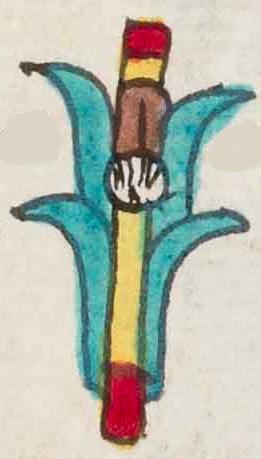acatl (Mdz23r)
This element of reeds (acatl) has been carved from the compound glyph for the place name Miacatla. There are two visuals in this element, which practically make it another compound. The tall, leafy, turquoise-colored plant typically serves as a glyph for acatl, but so does the arrow or dart made from a reed that appears in the middle of the plant. The added colors of red and yellow and the added feathers also recall the arrow (mitl), but various examples of acatl glyphs have these features.
Stephanie Wood
This element for (acatl) leaves little room for doubt that the viewer will read "aca," whether from the turquoise plant or the arrow or dart made from the reed stem or cane. Besides being a plant that was prevalent in the landscape, acatl was a year sign in the calendar.
Stephanie Wood
Stephanie Wood
c. 1541, but by 1553 at the latest
Stephanie Wood
reeds, canes, plants, arrows, darts, weapons, tules, carrizos, xiuhpohualli, año, turquesa, xihuitl, feathers, plumas

aca(tl), reed, https://nahuatl.wired-humanities.org/content/acatl
mi(tl), arrow, https://nahuatl.wired-humanities.org/content/mitl
reed, cane, arrow, dart
la caña, o la flecha
Stephanie Wood
Codex Mendoza, folio 23 recto, https://digital.bodleian.ox.ac.uk/objects/2fea788e-2aa2-4f08-b6d9-648c00..., image 56 of 188.
The Bodleian Libraries, University of Oxford, hold the original manuscript, the MS. Arch. Selden. A. 1. This image is published here under the UK Creative Commons, “Attribution-NonCommercial-ShareAlike 3.0 License” (CC-BY-NC-SA 3.0).

